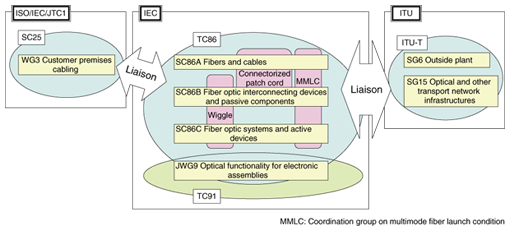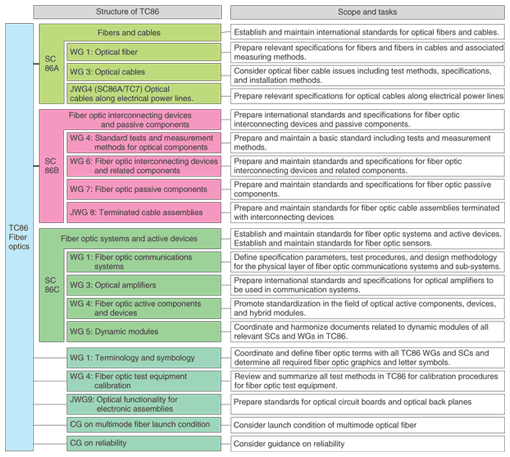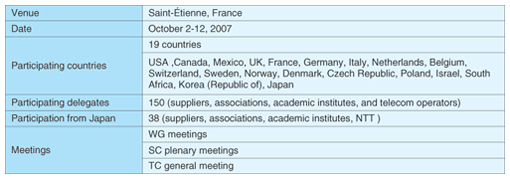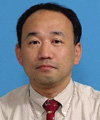 |
|||||
|
|
|||||
|
Global Standardization Activities Vol. 6, No. 5, pp. 42–46, May 2008. https://doi.org/10.53829/ntr200805gls Latest Standardization Activities in IEC TC86 (Fiber Optics)AbstractInternational Electrotechnical Commission Technical Committee 86 (IEC TC86) is responsible for international standardization in the field of fiber-optic communications. This article introduces recent TC86 standardization activities and topics arising from the meeting held from October 2–12, 2007 in Saint-Étienne, France.
1. IECThe International Electrotechnical Commission (IEC) is the leading global organization with regard to the preparation and publication of international standards for all electrical, electronic, and related technologies. Its objectives are to deal with all standardization problems and related issues such as assessing the conformity of these technologies. The objectives of Technical Committee 86 (TC86), which is called “Fiber Optics”, are to prepare standards for fiber-optic systems, modules, devices, and components intended primarily for use with communications equipment. The standards specified by TC86 cover terminology, characteristics, related tests, calibration and measurement methods, functional interfaces, and optical, environmental, and mechanical requirements with a view to ensuring reliable system performance by using appropriate quality assessment procedures. 2. Latest standardization activities in fiber opticsThis article describes recent progress in technology and changes in the market environment in this field since the last report in Feb. 2005 [1]. The most important change in TC86 is the start of standardization activities for a new field, namely optical circuit components, reflecting the expansion of the optical technology field. Research and development of technologies related to fiber optics started because of their potential for providing high-speed and broadband characteristics. The results were introduced into the transport networks of telecom operators first. Optical fiber is widely used in backbone networks and access networks to support Internet services and enterprise applications that require broadband transmission. As a result of those demands and applications that require high-speed data transmission, new issues have arisen related to delay in the electrical connection network and physical wiring space in and between equipment. In order to deal with these issues, standardization activities for optical circuit boards and optical connectors for circuit board attachment have started in TC91 (Electronic assembly technology). Since this technical field focuses on both optical technology and assembly technology, which are covered by two different TCs, TC86 decided to set up a new joint working group (JWG) to deal with this field. This group was established as TC86/JWG9 (with TC91) and called Optical functionality for electronic assemblies. In addition to this new activity, existing liaisons with related standardization organizations are also functioning more actively, reflecting the spread of optical technologies. The most important related standardization organizations are ITU-T (International Telecommunication Union, Telecommunication Standardization Sector) (SG6: Outside plant), SG15 (Optical and other transport network infrastructures), and ISO/IEC JTC1 SC25 WG3 (Customer premises cabling), as shown in Fig. 1. (SG: Study Group, JTC: Joint Technical Committee, SC: Subcommittee, WG: Working Group).
In ITU-T, SG6 is responsible for the installation, operation, and maintenance of outside plant, and SG15 is responsible for transmission systems and interfaces. In the fiber-optic field, ITU-T is mainly responsible for procedures and IEC is mainly responsible for products. Although these organizations cooperate, they remain separate and were established with different objectives, so some products and procedures, such as optical fibers, must be specified in each organization,. Therefore, the two organizations cooperate to avoid producing conflicting specifications. As a result of the expansion of optical technologies, these organizations have gained new members who are unfamiliar with their respective roles, so the harmony and cooperation between the organizations must be reconfirmed. ISO/IEC JTC1 SC25 WG3 is responsible for fiber on user premises with length of less than 3 km such as schools and industrial sites and specifies indoor/outdoor user network construction methods for use as a standard guide for users who want to construct their own networks. Optical fiber with broadband characteristics is also used in user premises networks. Because users want high-speed broadband networks, the user network requirements specified in their standards have recently tended to be for higher levels of performance. TC86 studies the needs and performances of products that JTC1 SC25 WG3 requests from the viewpoint of product experts and if necessary specifies the standard. JTC1 SC25 WG3 and TC86 maintain harmony and cooperation in user-side and product-side standardization. In addition to the smooth relationships between TC86 and other standardization organizations, there have recently been active studies involving the fields of several working group. SC86B/JWG8 is responsible for a connectorized patch cord, which consists of the patch cord studied in SC86A/WG3 and the optical connector studied in SC86B/WG6. And a coordination group on multimode fiber launch conditions, which is responsible for the launch conditions of multimode fiber, has been established as a TC level over SCs. A new study involving SC86B and SC86C has recently started. It aims to deal with the issue of wiggle at connection points between optical modules and optical cords. The structure and technical fields of TC86, which are subdivided into SCs and WGs, are shown in Fig. 2. The latest topics and tasks related to each WG are described below. An outline of the meeting is given in Table 1.
3. Latest topics discussed at Saint-Étienne meetingSC86A/WG1: Optical fiberThe addition of a new fiber type, corresponding to ITU-T/G.657 B6 bending-loss-insensitive single-mode fiber, to the product specifications was agreed. With regard to discussion of a new subcategory of plastic optical fiber, it was agreed that a study be undertaken under the leadership of JPNC (Japanese National Committee) SC86A/WG3: Optical cablesIn this meeting, it was agreed that definitions of measurement error and short term/long-term operating loads should continue to be discussed in an ad hoc group. With regard to a new work item, the proposal of drop fiber, JPNC made a presentation about the requirements and usage of drop fiber in Japan. The WG agreed that standardization activity should start with the goal of producing a Technical Report (TR). SC86B/WG4: Standard tests and measurement methods for optical componentsThe main discussions related to tests and measurement methods concerning multimode optical fiber issues and multifiber connectors. In a discussion about fiber-optic cylindrical connectors and the visual inspection of receptacle endfaces, JPNC led the discussion in order to reflect the performance of actual products in Japan in the specifications. SC86B/WG5: Reliability of optical componentsBecause this WG has been fairly inactive for some years it was disbanded and the work on existing standards and study items was passed to other WGs. SC86B/WG6: Fiber optic interconnecting devicesJPNC draft proposal for revision of the SC type and MU type optical connector interface standard was agreed. It was agreed that the procedure and rules of discussion in this WG should be discussed. This is because new work item proposals related to applied technology, such as water block optical connectors used for networks in factories, hybrid electrical/optical connectors for local area networks, and connectors for plastic optical fiber used in houses, are under active consideration in this WG's field. SC86B/WG7: Fiber optic passive componentsThis meeting discussed three sets of documents overseen by JPNC, namely the general specifications of isolators, the performance standard for 1310/1550-nm wavelength-division-multiplexing devices and dispersion compensators, and other documents such as the performance standard for optical branching devices, optical fuses, and optical limiters. Moreover, presentations were made by BT, Poland Telecom, and Telecom Italy in relation to passive optical networks (PONs). Since PONs are expected to become widely used as subscriber systems, particularly in Europe, performance standards for optical branching devices are attracting increased interest. SC86C/WG1: Fiber optic communications systemsThe revised draft of the jitter measurement method proposed by JPNC was approved. With regard to attenuation measurement for multimode fiber system, it was agreed that the 3rd CD (Committee Draft) reflecting the results of this meeting's discussion would be circulated since more than 200 comments on the 2nd draft were sent by national committees. SC86C/WG3: Optical amplifiersIn this meeting, there was discussion of existing standards related to methods for measuring optical parameters. As a result of this discussion, some clearly defined terminology and modifications to other standards were agreed. With regard to new standard specifications, it was agreed that two technical reports on the distributed Raman amplifier parameter measurement method and the wave mixing parameter measurement method in optical amplifiers proposed by JPNC would be discussed in the next WG meeting as a new work item. SC86C/WG4: Fiber optic active components and devicesWG4 discussed the revision of the existing performance standard for optical modules such as VCSELs (vertical cavity surface emitting lasers), and the package interface standard. It was agreed that we proceed to the standardization stage of these documents, taking into account the results of this discussion. With regard to new standard specifications, it was agreed that there should be a new work item concerning a method for measuring relative intensity noise with a time domain optical measurement system proposed by USNC (US National Committee). SC86C/WG5: Dynamic modulesDiscussion of a software/hardware interface and reliability led to the establishment of a policy for specification. Furthermore, some market research reports were presented on reconfigurable optical add-drop multiplexers and wavelength selectable switches. It was agreed that this information would be used to prepare a standardization draft. Moreover, JPNC reported experimental results for the effect of vibration on device performance and for the group delay ripple test method. TC86/JWG9: Optical functionality for electronic assembliesThis meeting completed a comment resolution for drafts of newly developed standards such as optical insertion loss at an optical board, a loss measurement method for isolators and mirrors, and the performance standard of flexible optical boards. It was agreed that these drafts should proceed to the committee draft stage. A presentation about a four-channel transceiver using an optical waveguide was given. 2008 TC86 general meeting in KyotoThe TC86 general meeting at Saint-Étienne decided that the next TC86 general meeting would be in Kyoto, Japan, and be hosted by JPNC. It will last for two weeks from October 27th. Since this is a chance to showcase JPNC and propose some technology developed in Japan, we will work very actively for its success. 4. Further standardization trends in IEC TC86The optical industrial field covered by IEC TC86 is expected to continue to be active to meet market demands and introduce developed technology. Japan is expected to continue to contribute and play an even more significant role. As regards technical trends in optical fiber, components and devices with various applications are being studied for specification as international standards, thus encouraging progress and diversification, especially in the field of access networks. Reference
|
|||||













